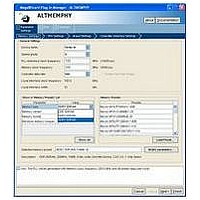IPR-HPMCII Altera, IPR-HPMCII Datasheet - Page 91

IPR-HPMCII
Manufacturer Part Number
IPR-HPMCII
Description
IP CORE Renewal Of IP-HPMCII
Manufacturer
Altera
Datasheet
1.IP-HPMCII.pdf
(176 pages)
Specifications of IPR-HPMCII
Software Application
IP CORE, Memory Controllers, SDRAM
Supported Families
Arria II GX, HardCopy III, Stratix III, Stratix IV
Core Architecture
FPGA
Core Sub-architecture
Arria, HardCopy, Stratix
Rohs Compliant
NA
Lead Free Status / RoHS Status
na
- Current page: 91 of 176
- Download datasheet (4Mb)
Chapter 5: Functional Description—ALTMEMPHY
Using a Custom Controller
December 2010 Altera Corporation
1
Calibration Process Requirements
When the global reset_n is released the ALTMEMPHY handles the initialization and
calibration sequence automatically. The sequencer calibrates memory interfaces by
issuing reads to multiple ranks of DDR3 SDRAM (multiple chip select). Timing
margins decrease as the number of ranks increases. It is impractical to supply one
dedicated resynchronization clock for each rank of memory, as it consumes PLL
resources for the relatively small benefit of improved timing margin. When
calibration is complete ctl_cal_success goes high if successful; ctl_cal_fail goes
high if calibration fails. Calibration can be repeated by the controller using the
soft_reset_n signal, which when asserted puts the sequencer into a reset state and
when released the calibration process begins again.
Other Local Interface Requirements
The memory burst length for DDR3 SDRAM devices can be set at either four or eight;
but when using the Altera high-performance controller, only burst length eight is
supported. For a half-rate controller, the memory clock runs twice as fast as the clock
provided to the local interface, so data buses on the local interface are four times as
wide as the memory data bus.
Address and Command Interfacing
Address and command signals are automatically sized for 1T operation, such that for
full-rate designs there is one input bit per pin (for example, one cs_n input per
chip select configured); for half-rate designs there are two. If you require a more
conservative 2T address and command scheme, use a full-rate design and drive the
address/command inputs for two clock cycles, or in a half-rate design drive both
address/command bits for a given pin identically.
Although the PHY inherently supports 1T addressing, the high-performance
controllers support only 2T addressing, so PHY timing analysis is performed
assuming 2T address and command signals.
Handshake Mechanism Between Read Commands and Read Data
When performing a read, a high-performance controller with the AFI asserts
ctl_doing_read to indicate that a read command is requested and the byte lanes that
it expects valid data to return on. ALTMEMPHY uses ctl_doing_read for the
following actions:
■
■
■
The read latency, ctl_rlat, is advertised back to the controller. This signal indicates
how long it takes in ctl_clk clock cycles from assertion of ctl_doing_read to valid
read data returning on ctl_rdata. The ctl_rlat signal is only valid when calibration
has successfully completed and never changes values during normal user mode
operation.
Control of the postamble circuit
Generation of ctl_rdata_valid
Dynamic termination (Rt) control timing
Section II. DDR3 SDRAM Controller with ALTMEMPHY IP User Guide
External Memory Interface Handbook Volume 3
5–39
Related parts for IPR-HPMCII
Image
Part Number
Description
Manufacturer
Datasheet
Request
R

Part Number:
Description:
IP NIOS II MEGACORE RENEW
Manufacturer:
Altera
Datasheet:

Part Number:
Description:
IP CORE Renewal Of IP-XAUIPCS
Manufacturer:
Altera
Datasheet:

Part Number:
Description:
IP CORE Renewal Of IP-10GETHERNET
Manufacturer:
Altera
Datasheet:

Part Number:
Description:
IP CORE Renewal Of IP-ASI
Manufacturer:
Altera
Datasheet:

Part Number:
Description:
IP CORE Renewal Of IP-CIC
Manufacturer:
Altera
Datasheet:

Part Number:
Description:
IP CORE Renewal Of IP-CRC
Manufacturer:
Altera
Datasheet:

Part Number:
Description:
IP CORE Renewal Of IP-ED8B10B
Manufacturer:
Altera
Datasheet:

Part Number:
Description:
CPLD, EP610 Family, ECMOS Process, 300 Gates, 16 Macro Cells, 16 Reg., 16 User I/Os, 5V Supply, 35 Speed Grade, 24DIP
Manufacturer:
Altera Corporation
Datasheet:

Part Number:
Description:
CPLD, EP610 Family, ECMOS Process, 300 Gates, 16 Macro Cells, 16 Reg., 16 User I/Os, 5V Supply, 15 Speed Grade, 24DIP
Manufacturer:
Altera Corporation
Datasheet:

Part Number:
Description:
Manufacturer:
Altera Corporation
Datasheet:










